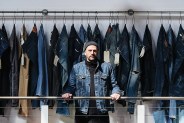In the period of 150 years, blue jeans have transitioned from workwear necessity to fashion staple. The uniquely American garment transcends social class, culture and trends. Though the birth of conventional jeans can be traced by to the early days of Levi’s, it wasn’t until the last half century that the number of boutique denim brands began to grow, and until the last couple decades that premium denim became a category. To explain the nuances that led to jeans’ worldwide adoption, we asked Paul Dillinger (Levi’s Head of Global Product Innovation) and Kiya Babzani (co-founder of leading selvedge denim retailer Self Edge) to weigh in on what kinds of construction, fabric and longevity characterize a great pair of jeans.
Think Big Picture
PD: There’s no single element that definitively makes a quality pair of jeans. The composition of a good pair of jeans relies on the relationships between components: a system of variables that are all related.
The one overarching feature of quality is intention. Is the mill committed to weaving quality denim? Is the manufacturer committed to building a quality garment? Have the designers, merchandisers and technical development specialists invested the time to make sure the fit is perfect and the styling and finishing are relevant? Everyone who touches the product — from the field to the factory to the retail floor — must have the making of a quality pair of jeans as their operative intention.
It’s All About the Denim
PD: We spend a lot of time and energy thinking about the look of denim; the features that the consumer can touch and feel. We work closely with our mill partners to get the perfect cast of the indigo and the most authentic visual characteristics — also making sure the cloth is comfortable and easy to wear.
Commensurate consideration is also given to features of the denim that can’t be seen or felt, but that are the essential building blocks of a quality pair of jeans. We scrutinize the spinning and weaving specifications, making sure the yarn’s twist and gauge are maximized for tensile strength. We assess the denim’s construction and weight to ensure the fabric can resist tearing and hold up to surface abrasion. We apply tests that simulate the wearing experience: Does the indigo easily rub off and stain other clothes? Does a stretch denim recover and return to its original shape? Does the fabric show strain or weakness at the seams?






